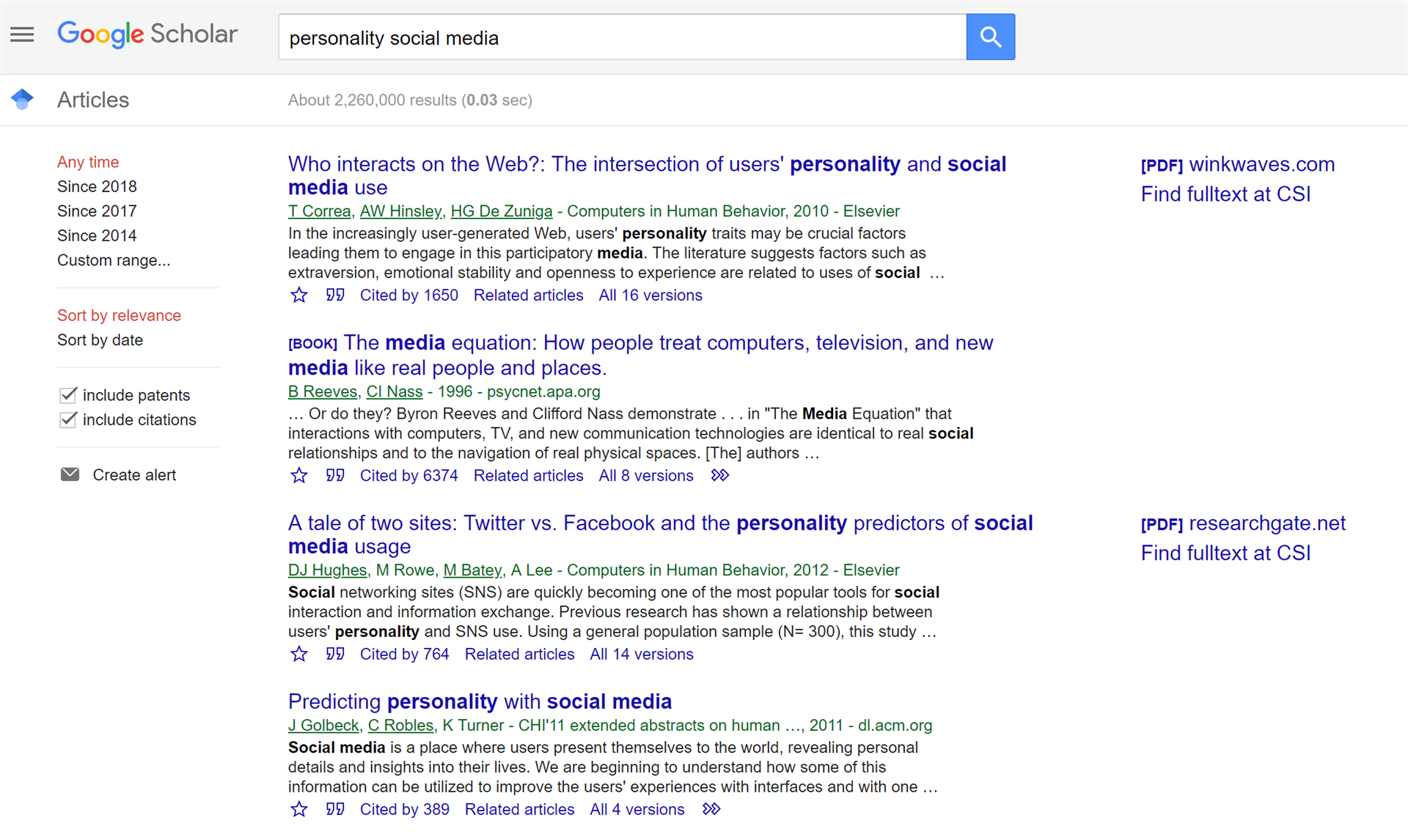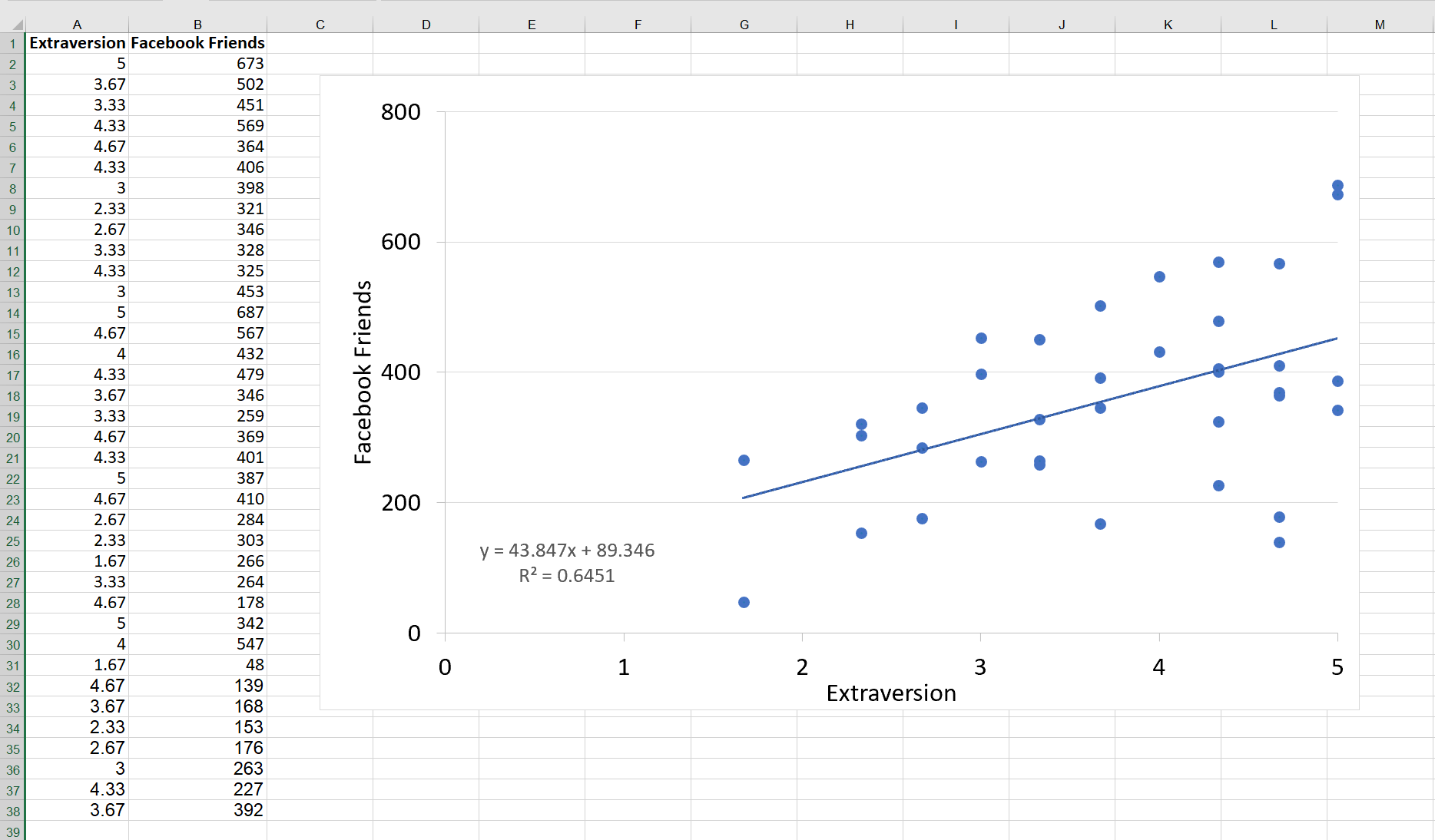By: Elizabeth S. Che and Patricia J. Brooks, The College of Staten Island and the Graduate Center, CUNY
In teaching Introductory Psychology, we aim to infuse a healthy dose of research methods into our lesson plans for each course topic. A key point that we emphasize throughout the semester is that all research starts with a question: What do we want to find out? Then, researchers select methods that are appropriate to address their question.
For our unit on personality, we pose the broad question: How does personality impact social media use? After posing the question, we demonstrate how to use Google Scholar to find existing research on the topic. Most of our students have never heard of Google Scholar and have limited, if any, experience reading journal article abstracts. As Part 1 of the activity, we identify possible keywords to use as search terms, such as personality and social media. Figure 1 below shows the results of our Google Scholar search as well as links to access some of the articles via our campus library.

Figure 1. Screenshot of Google Scholar results using keywords “personality” and “social media.”
The next step is to open up the links to view abstracts of relevant articles. When reading abstracts, we teach students to look for five key pieces of information: the rationale for the study, the research question, the results, the conclusion, and the implications. For example, the abstract for the first article, Who interacts on the Web: The intersection of users’ personality and social media use (Correa, Hinsley, & De Zuniga, 2010), summarizes a study identifying links between Big Five personality traits (i.e., openness, conscientiousness, extraversion, agreeableness, and neuroticism) and social media use. As a class exercise, we have students search for the five key pieces of information from one or more abstracts and paraphrase the findings in their own words. This semester, our students completed the paraphrasing exercise as a homework assignment, but it can also be implemented in class followed by discussion.
Part 2 of the activity involves generating our own dataset, which allows us to compare results from our class with the findings reported in the published articles. Here, we start by administering a short-form assessment of the Big Five Inventory (Lang, John, Lüdtke, Schupp, & Wagner, 2011). This assessment is a structured personality test consisting of three Likert-scale items for each of the Big Five traits. Items include, e.g., I see myself as someone who is outgoing, sociable. Students are instructed on how to score the assessment, including how to factor in responses on reverse-scored items.
Next, we ask students to take out their smartphones, check the number of Facebook friends that they have, and write the number on their Big Five worksheets (for students who are not on Facebook, we have “missing” data that can prompt discussions on how to operationalize variables such as social media use). At the end of the class period, we collect the results, emphasizing to the students that they should provide us with anonymous data. After tabulating the data in Excel, we create scatterplots in the next class to display results relating each personality factor to the number of Facebook friends (see Figure 2 for an example).

Figure 2. Screenshot of the class data and scatterplot relating extraversion and number of Facebook friends.
We demonstrate how to generate a best fit line to make clearer observations by clicking on “Chart Elements,” then “Trendline,” and lastly “Linear.” Double clicking on the trendline lets us add additional options, such as a linear equation and R-squared value. As we generate the scatterplots, we ask students to interpret them in relation to our research question—How does personality impact social media use?—while emphasizing that correlation does not imply causation. Using terminology such as positive, negative, and zero correlation, we evaluate the evidence linking specific personality factors with the number of Facebook friends. Finally, we ask students to compare the class results with findings from the previously reviewed articles. Further discussion may center on confounds, replicability, and issues of validity.
Introducing data collection in Introductory Psychology courses provides students with opportunities to develop quantitative thinking and research skills. Such skills include using databases to locate relevant prior research on a topic, reading scientific abstracts and paraphrasing information, generating graphs and statistics using spreadsheet software, and interpreting data.
References:
Correa, T., Hinsley, A. W., & De Zuniga, H. G. (2010). Who interacts on the Web?: The intersection of users’ personality and social media use. Computers in Human Behavior, 26(2), 247–253.
Lang, F. R., John, D., Lüdtke, O., Schupp, J., & Wagner, G. G. (2011). Short assessment of the Big Five: Robust across survey methods except telephone interviewing. Behavior Research Methods, 43(2), 548–567.
Elizabeth S. Che is a doctoral student in Educational Psychology at the Graduate Center, CUNY and the GSTA Deputy Chair. Her research interests include individual differences in language development, creativity, and pedagogy.
Patricia J. Brooks is Professor of Psychology at the College of Staten Island and the Graduate Center, CUNY and GSTA Faculty Advisor. Brooks was recipient of the 2016 President’s Dolphin Award for Outstanding Teaching at the College of Staten Island, CUNY. Her research interests are in two broad areas: (1) individual differences in language learning, (2) development of effective pedagogy to support diverse learners.
